Welcome to the ultimate guide on caring for succulents. Here, you’ll learn how to keep your succulents healthy and thriving. Succulents are popular for their unique look and easy care. This guide covers watering, fertilizing, and managing pests, helping your succulents flourish.
By following our tips, you can prevent common issues like too much or too little water. This guide will equip you with the knowledge to keep your succulents happy and healthy. It’s perfect for anyone looking to care for these plants.
With this guide, you’ll become a succulent expert. You’ll learn how to give your succulents the best care. Follow our advice to keep your succulents thriving.
Table of Contents
ToggleIntroduction to Succulent Care
Key Takeaways
- Learn the basics of succulent plant care
- Understand how to water and fertilize your succulents
- Discover how to repot and prune your succulents
- Learn how to identify and manage common pests and diseases
- Get tips on how to create a thriving succulent garden
- Understand the importance of proper care for succulent plants
Introduction to Succulents
Succulents are plants that thrive in dry places with little water. They are easy to care for, making them great for anyone, even those new to gardening. Succulent care is simple, which is why they’re perfect for busy people.
To care for succulents well, you need to know their specific needs. Lighting, watering, and soil are key. Understanding these will help you become a succulent expert. Let’s explore some important aspects of succulent care:
- Understanding the different types of succulents and their unique characteristics
- Learning how to provide the right amount of light and water for your succulents
- Choosing the right soil and potting mix for optimal drainage
By following these care tips, you’ll enjoy the many benefits of succulents. They not only purify the air but also add beauty to your space. Whether you’re new to gardening or experienced, succulent care is a rewarding hobby.
Exploring succulents, you’ll find many species, each with its own needs. From aloe vera to echeveria, there’s a succulent for everyone. Learning about these plants will help you care for them better and enjoy the rewards of succulent gardening.
Understanding Succulent Plant Needs
When caring for indoor succulents and outdoor succulents, knowing what they need is key. These plants have special needs that make them different from others. One important thing is light. Succulents need bright, indirect light to grow well.
Watering is also critical. Too much water can harm your plants, causing root rot. Finding the right amount of water depends on the soil, pot size, and climate. Learning how to water succulents correctly is a big step towards being a great gardener.
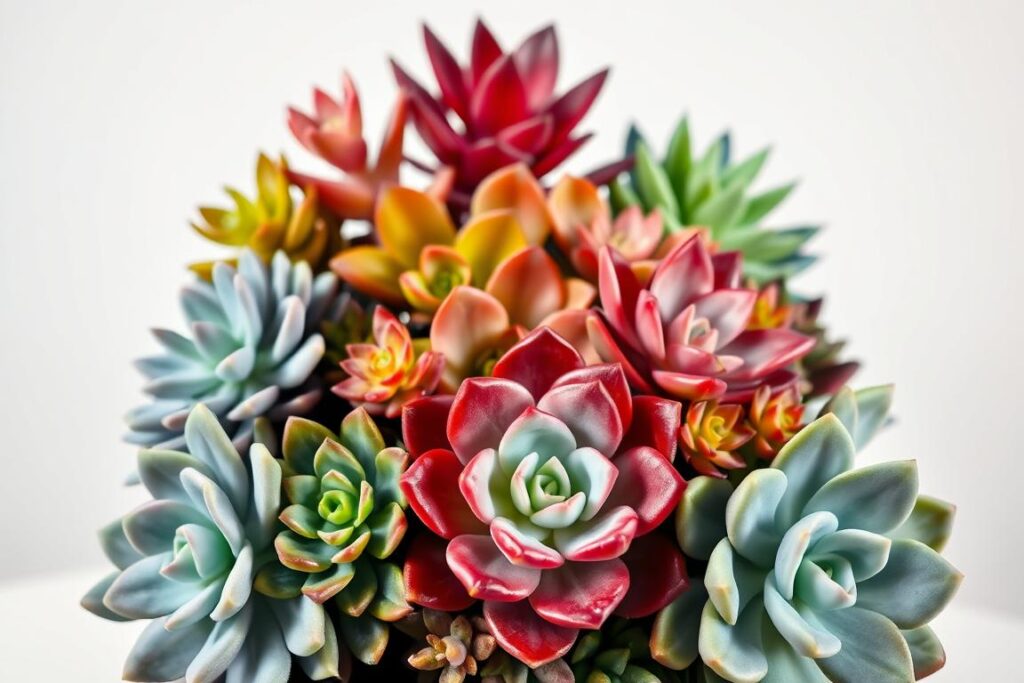
- Using well-draining soil to prevent waterlogged roots
- Providing adequate light, whether indoors or outdoors
- Watering sparingly, taking into account the specific needs of your plants
By following these tips and doing your homework, you can help your succulents thrive. Whether you’re new to gardening or have experience, knowing what your succulents need is essential for success.
Choosing the Right Container
Choosing the right container is key for your succulents’ health. The container affects the temperature and moisture, which are vital for the roots. Think about the best container for your succulents to thrive.
For succulent care, pick a container that drains well and has good air flow. Terra cotta, ceramic, or unglazed pots are great. They help prevent root rot by letting water out.
When picking a container, consider these factors:
- Material: Terra cotta, ceramic, or unglazed pots are good options
- Size: Choose a container that’s big enough for the roots but not too big
- Drainage: Make sure it has holes in the bottom for water to drain
By following these tips, you can help your succulents grow well. Remember, repotting is important for their care, and the right container is a big part of it.
Watering Techniques for Succulents
Watering succulents right is key. Too much water can harm them, while too little can make them weak. To know when to water, check the soil by sticking your finger in it up to the first knuckle. If it’s dry, it’s time to give them water.
Here are some succulent care tips to keep in mind:
- Water your succulents in the morning, so they can soak up the water all day.
- Use room-temperature water, as cold water can shock the roots.
- Water sparingly, as succulents are adapted to survive in dry conditions.
To learn how to take care of succulents, it’s important to understand their water needs. Follow these tips and watch how your plants react. This way, you can find the best watering schedule for them. It’s safer to water a bit less than too much, as you can always add more water.
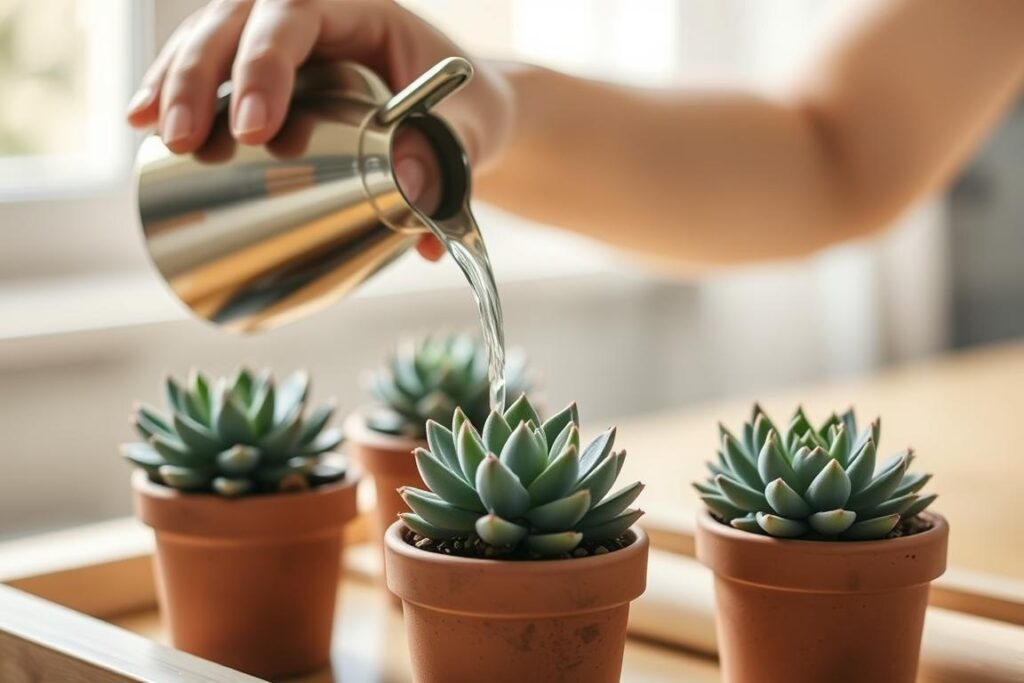
Fertilization Tips for Healthy Succulents
Wondering about fertilization in a succulent plant care guide? It’s key for growth and health. Fertilization is a vital part of caring for succulent plants. It’s often overlooked but greatly impacts your succulents’ health and look.
When picking a fertilizer, think about your succulent’s needs. You have many options, like organic and inorganic. Here are some popular ones:
- Organic fertilizers, such as compost or manure tea
- Inorganic fertilizers, such as balanced fertilizers or succulent-specific ones
Types of Fertilizers
Knowing the different fertilizers is important. Each has its benefits for your succulents. By choosing the right one, your succulents will get the nutrients they need.
How Often to Fertilize
Fertilization frequency varies by succulent type and growth stage. Generally, fertilize in spring and summer. Don’t fertilize in the dormant season to avoid harm. With the right succulent plant care guide and fertilization, your plants will thrive.
Repotting Succulents
As your succulents grow, they might outgrow their pots. This is a clear sign it’s time to repot them. Repotting gives them fresh soil, a bigger pot, and a clean place to grow.
When to Repot Your Succulent
Repot your succulent when the soil lacks nutrients or the plant is too big for its pot. Look for roots growing out of the drainage holes or the plant toppling over. Repot in spring or summer when they’re actively growing.
Step-by-Step Repotting Guide
To repot your succulent, follow these steps:
- Choose a pot that’s only slightly bigger than the old one to avoid wet soil.
- Use a potting mix that drains well to prevent waterlogged soil.
- Be gentle with the roots, trimming any dead or rotting ones.
- Water the succulent lightly after repotting to avoid root rot.
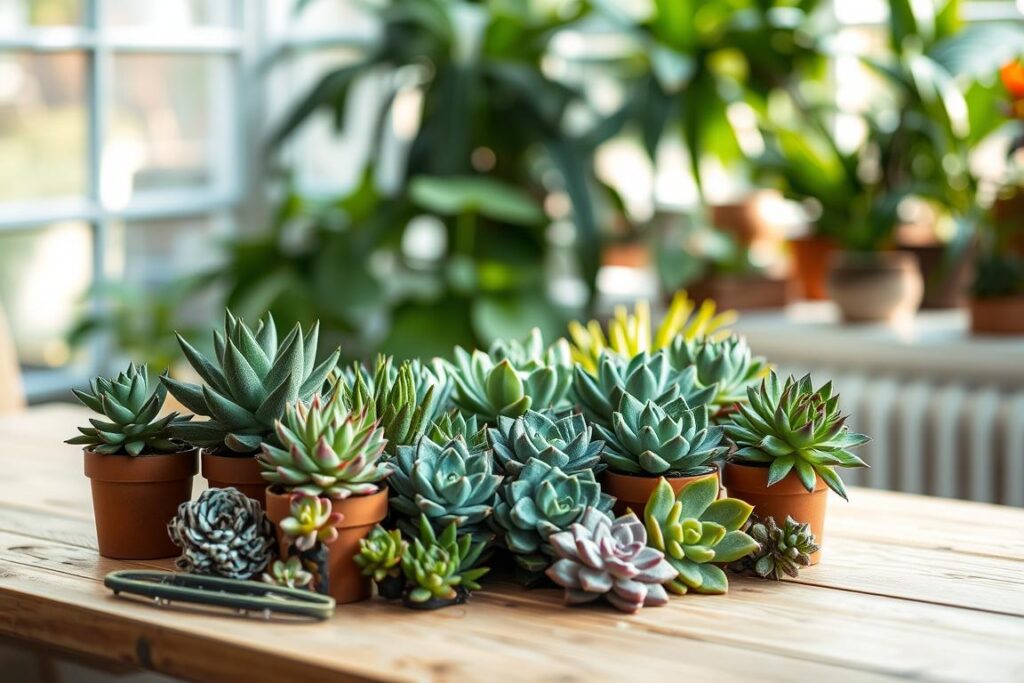
By following these steps and tips, you can ensure your succulents get the best care during repotting. They will continue to thrive as part of your succulent plant maintenance routine.
Pest Management for Succulents
Understanding pest management is key when caring for indoor and outdoor succulents. Pests can harm the leaves, stems, and roots of succulents. It’s important to know the common pests and how to prevent them.
For indoor succulents, keeping pests away is critical to stop them from spreading to other plants. Look for pests like mealybugs, spider mites, and scale. Outdoor succulents also need regular checks for pests, as they face more risks from the environment.
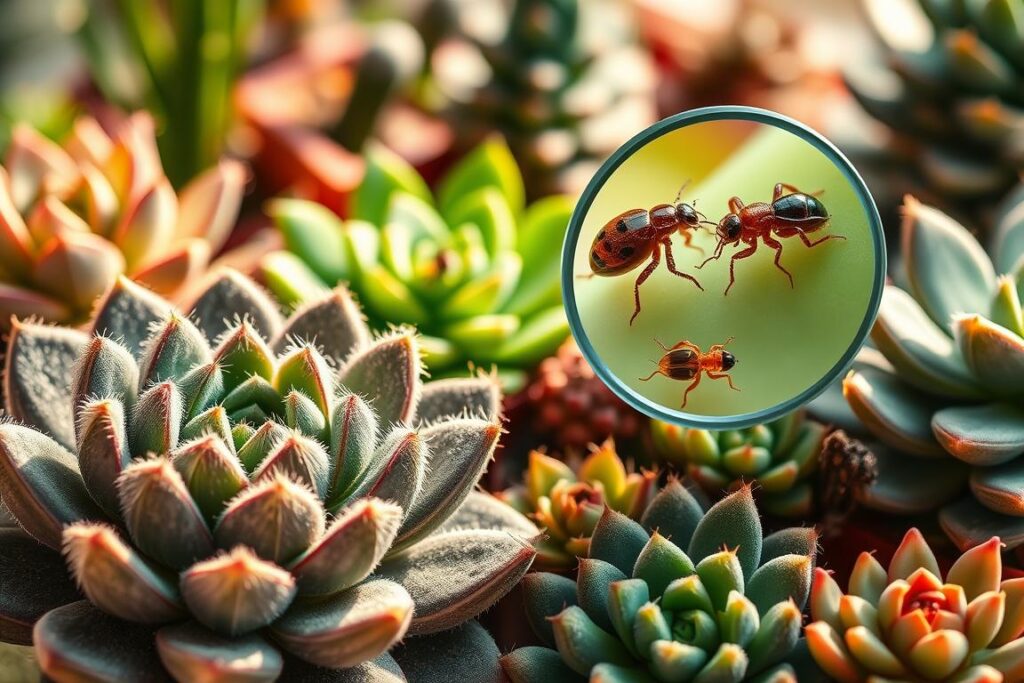
To fight pests, natural remedies like neem oil, insecticidal soap, and horticultural oil work well. They are safe for your succulents and help stop pests from spreading. Here are some tips for managing pests:
- Regularly check your succulents for pests
- Use natural remedies to prevent pest spread
- Keep infected plants separate to stop pests from spreading
By following these tips, you can keep your succulents healthy and thriving. Remember, prevention is key. Regular checks and care are vital for managing pests indoors and outdoors.
Propagation Techniques for Succulents
As you get better at caring for succulent plants, you might want to try propagation. This lets you make new plants from old ones. It’s a fun and rewarding thing to do. With the right succulent plant care guide, you can learn how to do it well.
There are a few ways to propagate succulents, like leaf cutting, offset division, and water propagation. Each method has its own steps and needs. But with the right succulent care tips, you can do it right.
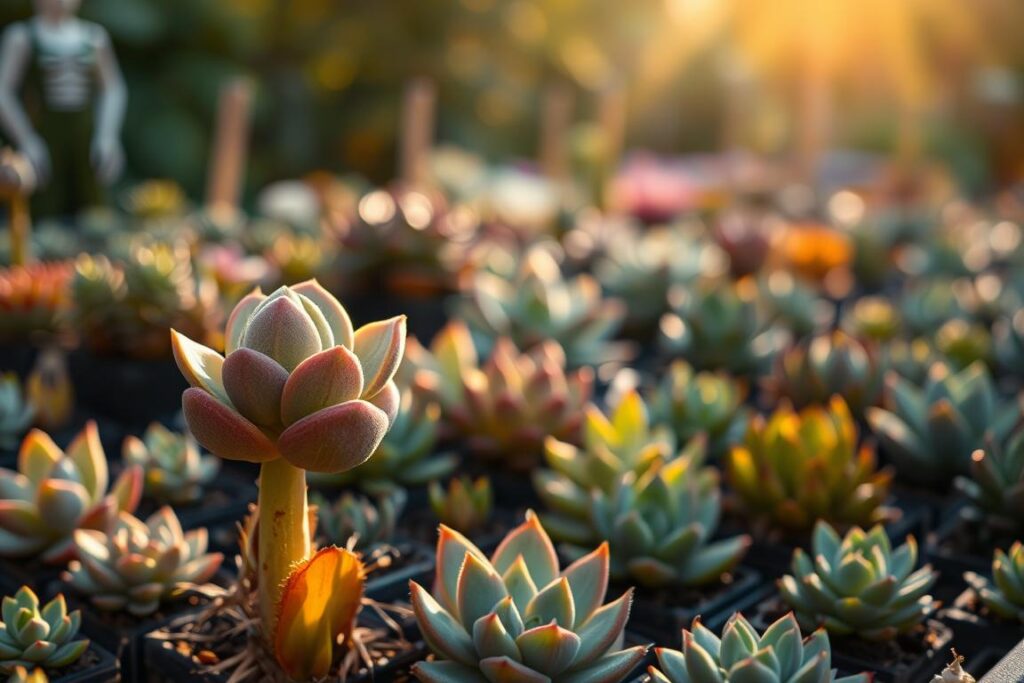
Leaf Cutting Method
This method means cutting a leaf from the mother plant and letting it dry for a few days. Then, you can plant it in soil and water it a little until it grows roots.
Offset Division Method
This method is about dividing the offsets, or baby plants, that grow around the mother plant’s base. You can separate these and plant them in their own pots. They will grow into new plants.
Water Propagation
This method is about putting the cut end of a leaf or stem in water and letting it grow roots. Once the roots are there, you can move the plant to soil.
By using these propagation techniques and a good succulent plant care guide, you can make new succulent plants. You can enjoy them or share them with others. Always take care of your new plants properly to keep them healthy and thriving.
Seasonal Care for Succulents
As you care for your succulents, remember the seasons change. Indoor succulent care and outdoor succulent care need adjustments. Knowing these changes helps you care for your plants better.
For seasonal care, you’ll need to change how you water, fertilize, and prune. In spring and summer, your succulents need more water and food. But in fall and winter, water and food less to avoid root rot.
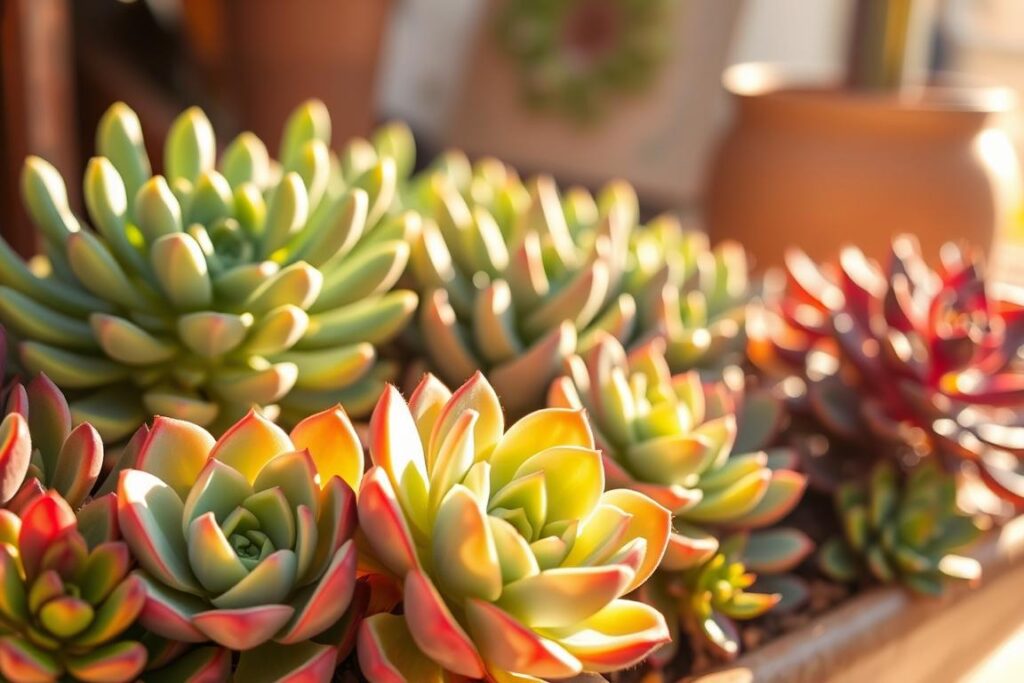
- Reduce watering to once a month or less, based on temperature and humidity.
- Protect from frost and cold by moving plants indoors or using a frost blanket.
- Don’t fertilize in winter, as new growth can be harmed by cold.
By following these seasonal care tips, your succulents will do well all year. Watch how your plants react to the seasons. Adjust your care to keep them healthy and happy.
Troubleshooting Common Problems
As you care for your succulents, you might face some common issues. A good succulent plant care guide should help you solve these problems. Knowing the signs of overwatering, underwatering, and disease is key. This way, you can act fast and keep your plants healthy.
It’s important to regularly check on your succulents. Look for soft, mushy leaves from too much water and wrinkled, shriveled leaves from too little. Catching these problems early helps you adjust your watering and save your plants.
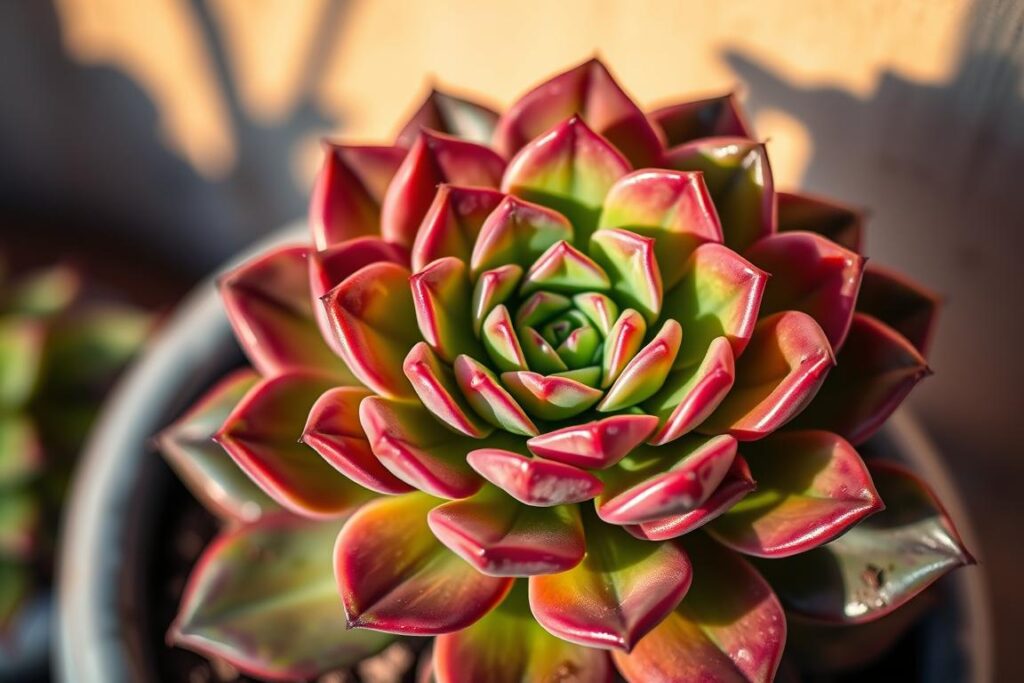
To fix common problems, you need to know how to troubleshoot. This means figuring out the cause, like too much or too little water, or disease. Then, you take steps to fix it. By following these tips, you can keep your succulents in top shape.
Some common issues to watch out for include:
- Overwatering, which can lead to root rot and other problems
- Underwatering, which can cause leaves to become wrinkled and discolored
- Disease, which can spread quickly if left untreated
Conclusion: Enjoying Your Succulent Garden
This succulent plant care guide has shown you the way to a thriving garden. By following the right techniques, your succulents will flourish. They will bring you joy for a long time.
One of the best parts of succulent care is growing new plants. You can do this from leaf cuttings or offsets. This lets you grow your collection and create stunning displays at home or outside.
Being patient and careful is key when you care for succulents. With time, you’ll get better at it. Enjoy watching your garden grow and be proud of your beautiful, easy-to-care-for space.
FAQ
What are the most common types of succulents?
Common succulents include aloe, jade, echeveria, sedum, and hen and chicks. Each has its own look and care needs.
How often should I water my succulents?
Watering depends on the succulent type, season, and growing conditions. Water when the soil is dry. This is usually every 1-2 weeks in growing seasons and 2-4 weeks in winter.
What type of soil do succulents prefer?
Succulents love well-draining, sandy soil. Use a mix made for succulents or a mix of potting soil, perlite, and sand.
How much sunlight do succulents need?
Succulents need 6 hours of direct sunlight daily. Many prefer 8-10 hours. Give them bright, indirect light and use grow lights if needed.
How often should I fertilize my succulents?
Succulents need little fertilizer. Fertilize every 2-3 months in spring and summer. Use a balanced, diluted liquid fertilizer or slow-release.
When should I repot my succulents?
Repot every 1-2 years. Check for roots growing out of holes or if the plant is top-heavy. This means it’s time to repot.
How can I prevent pests on my succulents?
Keep plants healthy and stress-free. Avoid overwatering and check for pests often. Use natural remedies like neem oil or insecticidal soap for pests.
Can I propagate my succulents?
Yes, you can propagate succulents through leaf or stem cuttings, or by dividing offsets. It’s a great way to grow new plants.
How do I care for my succulents in the winter?
In winter, succulents need less water and no fertilizer. Give them as much light as possible. Keep them from frost and cold by moving them indoors or using a sheltered spot outside.














